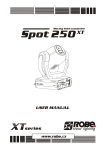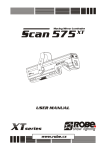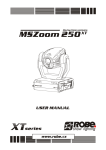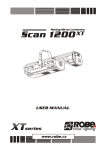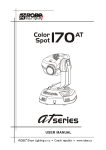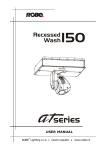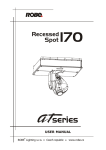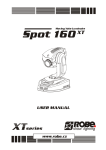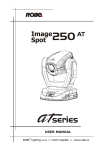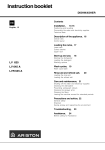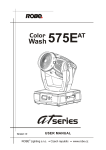Download Robe ColorWash 575E AT Specifications
Transcript
1
SPOT 575 XT
Table of contents
1. Safety instructions ......................................................................................................... 3
2.Operating determinations .............................................................................................. 4
3. Description of the device .............................................................................................. 5
4. Installation ...................................................................................................................... 6
4.1Fitting the lamp ........................................................................................................... 6
4.2 Lamp adjustment ....................................................................................................... 7
4.3 Inserting/Exchanging gobos...................................................................................... 7
4.4 Rigging the fixture ..................................................................................................... 8
4.5 Connection to the mains .......................................................................................... 10
4.6 DMX-512 connection/connection between fixtures ................................................. 10
5. DMX PROTOCOL .......................................................................................................... 11
6. Controller mode ........................................................................................................... 14
6.1 DMX addressing ..................................................................................................... 14
6.2 Remotely controllable functions .............................................................................. 14
7. Stand - alone mode ...................................................................................................... 15
8. Functions of the control panel.................................................................................... 16
8.1 Addressing .............................................................................................................. 16
8.2 Slave control ........................................................................................................... 17
8.3 Fixture informations ................................................................................................. 17
8.4 Personality options .................................................................................................. 19
8.5 Switching On/Off the lamp ....................................................................................... 23
8.6 Test sequences........................................................................................................ 24
8.7 Stand-alone setting ................................................................................................. 24
8.8 Reset function ......................................................................................................... 26
8.9 Special functions ..................................................................................................... 26
9. Error and information messages ................................................................................ 28
10.Technical specifications ............................................................................................ 30
11. Maintenance and cleaning ........................................................................................ 33
12. Appendix .................................................................................................................... 34
12.1 Changing the power supply settings ..................................................................... 34
2
CAUTION!
Keep this device away from rain and moisture!
Unplug mains lead before opening the housing!
FORYOUR OWN SAFETY, PLEASE READ THIS USER MANUAL CAREFULLY
BEFORE YOU INITIAL START - UP!
1. Safety instructions
Every person involved with installation and maintenance of this device have to:
- be qualilfied
- follow the instructions of this manual
CAUTION!
Be careful with your operations.
With a high voltage you can suffer
a dangerous electric shock when touching the wires!
This device has left our premises in absolutely perfect condition. In order to maintain this condition and to ensure
a safe operation, it is absolutely necessary for the user to follow the safety instructions and warning notes written
in this manual.
Important:
The manufacturer will not accept liability for any resulting damages caused by the non-observance of this manual
or any unauthorized modification to the device.
Please consider that damages caused by manual modifications to the device are not subject to warranty.
Never let the power-cord come into contact with other cables! Handle the power-cord and all connections with the
mains with particular caution!
Make sure that the available voltage is not higher than stated on the rear panel.
Always plug in the power plug least. Make sure that the power-switch is set to OFF-position before you connect
the device to the mains. The power-plug has to be accessable after installing the device.
Make sure that the power-cord is never crimped or damaged by sharp edges. Check the device and the powercord from time to time.
Always disconnect from the mains, when the device is not in use or before cleaning it. Only handle the power-cord
by the plug. Never pull out the plug by tugging the power-cord.
This device falls under protection class I. Therefore it is essential to connect the yellow/green conductor to earth.
The electric connection, repairs and servicing must be carried out by a qualified employee.
Do not connect this device to a dimmer pack.
Do not switch the fixture on and off in short intervals as this would reduce the lamp’s life.
During the initial start-up some smoke or smell may arise. This is a normal process and does not necessarily
mean that the device is defective.
Do not touch the device’s housing bare hands during its operation (housing becomes hot)!
For replacement use lamps and fuses of same type and rating only.
CAUTION ! EYEDAMAGES !
Avoid looking directly into the light source
(meant especially for epileptics) !
3
2.Operating determinations
This device is a moving-head spot for creating decorative effects and was designed for indoor use only.
If the device has been exposed to drastic temperature fluctuation (e.g. after transportation), do not switch it on
immediately. The arising condensation water might damage your device. Leave the device switched off until it has
reached room temperature.
Never run the device without lamp!
Do not shake the device. Avoid brute force when installing or operating the device.
Never lift the fixture by holding it at the projector-head, as the mechanics may be damaged. Always hold the
fixture at the transport handles.
When choosing the installation-spot, please make sure that the device is not exposed to extreme heat, moisture
or dust. There should not be any cables lying around. You endanger your own and the safety of others!
The minimum distance between light-output and the illuminated surface must be more than 2 meters.
Make sure that the area below the installation place is blocked when rigging, derigging or servicing the fixture.
Always fix the fixture with an appropriate safety-rope. Fix the safety-rope at the correct holes only.
Only operate the fixture after having checked that the housing is firmly closed and all screws are tightly fastened.
The lamp must never be ignited if the objective-lens or any housing-cover is open, as discharge lamps may
explose and emit a high ultraviolet radiation, which may cause burns.
The maximum ambient temperature ta = 40° C must never be exceeded. Otherwise, the lamp is switched off and
the fixture is out of operation for 5 minutes.
CAUTION!
The lens has to be replaced when it is obviously damaged,
so that its function is impaired, e. g. due to cracks or deep scratches!
Operate the device only after having familiarized with its functions. Do not permit operation by persons not
qualified for operating the device. Most damages are the result of unprofessional operation!
CAUTION!
The lamp has to be replaced when it is damaged
or deformed due to the heat!
Please use the original packaging if the device is to be transported.
Please consider that unauthorized modifications on the device are forbidden due to safety reasons!
If this device will be operated in any way different to the one described in this manual, the product may suffer
damages and the guarantee becomes void. Furthermore, any other operation may lead to dangers like shortcircuit, burns, electric shock, burns due to ultraviolet radiation, lamp explosion, crash etc.
4
3. Description of the device
1 - Moving head
2 - Yoke
3 - Carry handles
4 - Base
Rear panel:
5 - Power switch
6 - DMX output
7 - DMX input
8 - Power cord
9 - Fuse holder
Front panel:
10 - Mode-button
11 - Enter-button
12 - Up-button
13 - Down-button
14 - Display
5
4. Installation
4.1Fitting the lamp
DANGER !
Install the lamps with the device switched off only.
Unplug from mains before !
To insert the lamp MSR 575/2 95V/575W GX-9,5 loosen the lamp cover at the rear of head (see the drawings ) by
remowing the 3 fastening screws which are marked "X,Y,Z".Carefully pull out the cover with the lamp socket
assembly.If changing the lamp, remove the old lamp from the socket. Insert the lamp to the socket.
Do not install a lamp with a higher wattage! A lamp like this generates temperatures the device is not designed for.Damages caused by non-observance are not subject to warranty. Please follow the lamp
manufacturer‘s notes!Do not touch the glass-bulb with bare hands during the installation! Make sure that the
lamp is installed tightly into the lampholder system.
Reclose the lamp cover and tighten the 3 screws.
Before striking the lamp, reset the "LAti"and "LASt" counter s in the menu of the Control Board, by pressing the
"Up" and "Down" buttons in one time and then confirming with the Enter-button.
Lamp assembly:
Lamp cover
3 phillips screws "X,Y,Z"
Do not operate this fixture with opened housing-cover!
6
4.2 Lamp adjustment
3 adjustment screws "A,B,C"
The SPOT 575 XT lampholder is aligned at the factory. Due to differences between lamps, fine adjustment may
improve light performance.
Strike the lamp,open the shutter and the iris,set the dimmer intensity onto 100% and focus the light on a flat
surface (wall).Center a hot-spot(the brightest part of the image) by using the 3 adjustment screws "A,B,C".Turn
one screw after another a quarter-turn clokwise(counter-clokwise) to set the hot-spot in the center of the image.If
you cannot detect the hot-spot,adjust the lamp until the light is evenly distributed.
4.3 Inserting/Exchanging gobos
DANGER!
Install the gobos with the device switched off only.
Unplug from mains before!
If you wish to use other forms and patterns as the standard-gobos, or if gobos are to be exchanged, open the top
cover of the head by loosening 2 screws on the top cover.
Remove the fixation ring with an appropriate tool. Remove the gobo and insert the new gobo. Press the fixation
ring together and insert it in the front of the gobo.
CAUTION!
Never unscrew the screws of the rotating gobo
as the ball bearing will otherwise be opened!
7
4.4 Rigging the fixture
DANGER TO LIFE!
Please consider the respective national norms during the installation!
The installation must only be carried out by an authorized dealer!
The installation of the projector has to be built and constructed in a way that it can hold 10 times the weight for 1
hour without any harming deformation.
The installation must always be secured with a secondary safety attachment, e.g. an appropriate catch net. This
secondary safety attachment must be constructed in a way that no part of the installation can fall down if the
main attachment fails.
When rigging, derigging or servicing the fixture staying in the area below the installation place, on bridges, under
high working places and other endangered areas is forbidden.
The operator has to make sure that safety-relating and machine-technical installations are approved by an expert
before taking into operation for the first time and after changes before taking into operation another time.
The operator has to make sure that safety-relating and machine-technical installations are approved by an expert
after every four year in the course of an acceptance test.
The operator has to make sure that safety-relating and machine-technical installations are approved by a skilled
person once a year.
The projector should be installed outside areas where persons may walk by or be seated.
IMPORTANT! OVERHEAD RIGGING REQUIRES EXTENSIVE EXPERIENCE, including (but not limited to)
calculating working load limits, installation material being used, and periodic safety inspection of all installation
material and the projector. If you lack these qualifications, do not attempt the installation yourself, but instead use
a professional structural rigger. Improper installation can result in bodily injury and.or damage to property.
The projector has to be installed out of the reach of people.
If the projector shall be lowered from the ceiling or high joists, professional trussing systems have to be used. The
projector must never be fixed swinging freely in the room.
Caution: Projectors may cause severe injuries when crashing down! If you have doubts concerning the safety of
a possible installation, do NOT install the projector!
Before rigging make sure that the installation area can hold a minimum point load of 10 times the projector’s
weight.
Danger of fire !
When installing the device, make sure there is no highly inflammable
material (decoration articles, etc.) in between a distance of min. 0,7 m.
CAUTION!
Use 2 appropriate clamps to rig the fixture on the truss.
Follow the instructions mentioned at the bottom of the base.
Make sure that the device is fixed properly! Ensure that the structure (truss)
to which you are attaching the fixtures is secure.
The projector can be placed directly on the stage floor or rigged in any orientation on a truss without altering its
operation characteristics .
8
For overhead use, always install a safety-rope that can hold at least 10 times the weight of the fixture. You must
only use safety-ropes with screw-on carabines. Pull the safety-rope through the two apertures on the bottom of
the base and over the trussing system etc. Insert the end in the carabine and tighten the fixation screw.
Fixation via the omega holders
1.Bolt each clamp (1) to the omega holder (4) with M12 bolt and lock nut through the hole in the holder.
2.Fasten the omega holders on the bottom of the base by inserting both quick-lock fasteners (3) into the holes of
the base and tighten fully clockwise.
3.Fasten the safety-rope (2) through the two apertures on the bottom of the base and over the trussing system.
1-Clamp
2-Safety-rope
3-Quick-lock fastener
4-Omega holder
When installing fixtures side-by-side,
avoid illuminating one fixture with another!
DANGER TO LIFE!
Before taking into operation for the first time,the installation has to be approved
by an expert!
9
4.5 Connection to the mains
Verify the power supply settings before applying power!
If you wish to change the power supply settings,see the chapter Appendix.
Connect the fixture to the mains with the enclosed power cable and plug.
The earth has to be connected!
The occupation of the connection-cables is as follows:
Cable (EU)
Cable (US)
Pin
International
L
Brown
Black
Live
Light blue
White
Neutral
Yellow/Green
Green
Earth
N
4.6 DMX-512 connection/connection between fixtures
Controller operation
Master/slave operation
Only use a stereo shielded cable and 3-pin XLR-plugs and connectors in order to connect the controller with the
fixture or one fixture with another.
Occupation of the XLR-connection:
DMX - output
DMX-input
XLR mounting-socket:
XLR mounting-plug:
1 - Ground
2 - Signal (-)
3 - Signal (+)
1 - Ground
2 - Signal (-)
3 - Signal (+)
If you are using the standard DMX -controllers, you can connect the DMX-output of the controller directly with the
DMX-input of the first fixture in the DMX-chain. If you wish to connect DMX-controllers with other XLR-outputs,
you need to use adapter-cables.
Building a serial DMX-chain:
Connect the DMX-output of the first fixture in the DMX-chain with the DMX-input of the next fixture. Always
connect one output with the input of the next fixture until all fixtures are connected.
Caution: At the last fixture, the DMX-cable has to be terminated with a terminator. Solder a 120 W resistor
between Signal (–) and Signal (+) into a 3-pin XLR-plug and plug it in the DMX-output of the last fixture.
10
5. DMX PROTOCOL
Mode 1 Mode 2 8 bit
Value
channel channel channel
1
1
1
2
3
4
3
Pan
Pan movement by 530°
proportional
0-255
Tilt
Tilt movement by 280°
proportional
0-255
Pan fine
Fine control of pan movement
proportional
Tilt fine
Fine control of tilt movement
proportional
2
4
0-255
5
3
6
6
4
Speed of PAN/TILT movement
0
Max. speed (tracking mode)
step
1-249 From max. speed to min.speed (vector mode) proportional
250-252 Max. speed,(track.mode),black-out while color or
step
gobo changes
253-255 Max.speed (vector mode) ,black out while pan/tilt step
moving or color/gobo changes
0-127
128-139
140-229
230-239
240-255
7
7
5
0
13
26
38
51
64
77
90
102
115
128-190
191-193
194-255
0-255
8
8
Type of control
0-255
2
5
Function
6
0-11
12-23
24-35
36-47
48-59
60-71
72-83
84-95
96-107
108-119
Lamp on/off,reset,fans speed control
From max.speed of fan to min. speed of fan
Lamp on,reset,
No function
Lamp off after 3 sec
No function
proportional
step
step
step
step
Colours 1
Open/white
proportional
Light blue
proportional
Red
proportional
Blue
proportional
Light green
proportional
Yellow
proportional
Magenta
proportional
Cyan
proportional
Green
proportional
Orange
proportional
Forwards rainbow effect from fast to slow
proportional
No rotation
step
Backwards rainbow effect from slow to fast
proportional
Colour macro function (channel 8 set from 128proportional
255)-64 different colours in following order:white,
pink,magenta,red,orange,yellow,green,cyan,blue,UV
Colours 2
White
Deep red
Deep blue
Pink
Cyan
Magenta
Yellow
5600K correction filter
3200K correction filter
UV filter
11
step
step
step
step
step
step
step
step
step
step
Mode 1 Mode 2 8 bit
Value
Function
Type of control
channel channel channel
120-127 White
128-255 Enable macro color function on channel 7
9
10
11
9
10
11
7
3-facet prism rotatin control,Prism macros
0
Open position (no prism)
1- 63
Forwards rotation from fast to slow
64
No rotation
65-127 Backwards rotation from slow to fast
128-255 Prism/gobo macros
128-135 Macro 1
136-143 Macro 2
144-151 Macro 3
152-159 Macro 4
160-167 Macro 5
168-175 Macro 6
176-183 Macro 7
184-191 Macro 8
192-199 Macro 9
200-207 Macro 10
208-215 Macro 11
216-223 Macro 12
224-231 Macro 13
232-239 Macro 14
240-247 Macro 15
248-255 Macro 16
8
0-7
8-15
16-23
24-31
32-39
40-47
48-55
56-63
64-71
72-79
80-223
80-95
96-111
112-127
128-143
144-159
160-175
176-191
192-207
208-223
224-255
Static gobos
Open/hole
Gobo 1
Gobo 2
Gobo 3
Gobo 4
Gobo 5
Gobo 6
Gobo 7
Gobo 8
Gobo 9
Shaking gobos with variable speed
Gobo 1
Gobo 2
Gobo 3
Gobo 4
Gobo 5
Gobo 6
Gobo 7
Gobo 8
Gobo 9
Gobo wheel rotation from slow to fast
0-31
32-63
64-95
96-127
128-159
160-191
192-223
224-255
Rotating gobos
Open/hole
Rot.gobo 1 (metal)
Rot.gobo 2 (metal)
Rot.gobo 3 (metal)
Rot.gobo 4 (dichroic)
Rot.gobo 5 (dichroic)
Rot.gobo 6 (glass)
Rot.gobo wheel cont.rotation from slow to fast
9
12
step
step
step
proportional
step
proportional
step
step
step
step
step
step
step
step
step
step
step
step
step
step
step
step
step
step
step
step
step
step
step
step
step
step
step
step
step
step
step
step
step
step
step
proportional
step
step
step
step
step
step
step
proportional
Mode 1 Mode 2 8 bit
Value
Function
Type of control
channel channel channel
12
12
10
0-127
128-190
191-192
193-255
13
13
11
0
1-179
180-191
192-223
224-255
14
15
14
15
12
16
proportional
proportional
step
proportional
Iris
Open
Max.diameter to min.diameter
Closed
Pulse closing from slow to fast
Pulse opening from fast to slow
step
proportional
step
proportional
proportional
Focus,multistep zoom
0-85
Zoom 15°-Continuous adjustment from far to near
86-170 Zoom 18°-Continuous adjustment from far to near
171-225 Zoom 22°-Continuous adjustment from far to near
proportional
proportional
proportional
Shutter,strobe
Shutter closed
No function (Shutter open)
Strobe-effect from slow to fast (max.10 flashes/s)
No function (Shutter open)
Pulse-effect in sequences from slow to fast
No function (Shutter open)
Random strobe-effect from slow to fast
No function (Shutter open)
step
step
proportional
step
proportional
step
proportional
step
13
0-31
32-63
64-95
96-127
128-159
160-191
192-223
224-255
16
Rotating gobo index,rotating gobo rotation
Gobo indexing
Forwards gobo rotation from fast to slow
No rotation
Backwards gobo rotation from slow to fast
14
0-255
Dimmer intensity
Gradual adjustment of the dimmer intensity
from 0 to 100%
13
proportional
6. Controller mode
The fixtures are individually addressed (001-497) on a data link and connected to the controller.The fixtures
respond to the DMX signal from the controller.
6.1 DMX addressing
The control panel on the front panel of the fixture allows you to assign the DMX fixture address, which is defined
as the first channel from which the SPOT 575 XT will respond to the controller.
If you set, for example, the address to channel 5, the SPOT 575 XT will use the channel 5 to 20 for control.
Please, be sure that you don’t have any overlapping channels in order to control each SPOT 575 XT correctly and
independently from any other fixture on the DMX data link.
If two, three or more SPOT 575 XT are addressed similarly, they will work similarly.
For address setting, please refer to the instructions under "Addressing"(menu "A001").
Controlling:
After having addressed all SPOT 575 XT , you may now start operating these via your lighting controller.
Note:After switching on, the SPOT 575 XT will automatically detect whether DMX 512 data is received or not.If
there is no data received at the DMX-input, the display will start to flash "A001" with actually set address.
This situation can occur if:
- the 3 PIN XLR plug (cable with DMX signal from controller) is not connected with the input of the SPOT 575 XT
- the controller is switched off or defective, the cable or connector is defective or the signal wires are swap in the
input connector.
Note:It’s necessary to insert the XLR termination plug (with 120 Ohm) to the last fixture in the link in order to
ensure proper transmission on the DMX data link.
6.2 Remotely controllable functions
Lamp
The SPOT 575 XT is to be operated with a Philips MSD 575,MSR 575/2 or Osram HSR 575/2 lamp.
A relay inside of the SPOT 575 XT allows you to switch on and off the lamp via the control panel or via your DMXcontroller without affecting the rest of the lighting.
To switch On/Off the lamp, please refer to "Switching On/Off the lamp " (menu "LAMP").
Note: It is also important to note, that the discharge lamp is cold restrike types, that means, that they have to be
cold before re-striking. For this reason, you have to wait 5 minutes (max. speed of fan must be adjusted) after
having switched Off the lamp before you can switch it back On again. If you try to switch On the lamp within 5
minutes after having switched it Off, the SPOT 575 XT will store this information and automatically ignite the lamp
when the 5 minutes period has expired. The message "HEAt" will appear on the control panel display of the SPOT
575 XT. If the ignition of the lamp is seven times unsuccessful, on the display will appear "LA.Er", meaning that
the lamp could be damaged or even missed, or there could be a failure on the ignitor or ballast.
Static gobo wheel
The static gobo wheel includes 9 metal gobos ,gobo-shake function.
Rotating gobo wheel
The rotating gobo wheel includes 3 metal gobos, 1 glass gobo and 2 dichroic gobos rotating in both directions,
indexable, rotating gobo wheel continuousli rotation from slow to fast. The rotating gobos can be interchanged.
3-facet rotating prism
The 3-facet prism rotating in both directions at different speeds,16 prism-gobo macros
Iris
Motorized adjustable iris,variable pulse effects.
Focus-multistep zoom
Motorized focus enables the beam to be focused anywhere on stage at different beam angles: 15°,18°,22°,provided
by the special multistep zoom.
14
Dimmer/Shutter/Strobe
Smooth 0 - 100 % dimming is provided by the combined mechanical dimmer/shutter unit. This unit may also be
used for strobe effect (1 - 10 flashes per second)
Fans
The SPOT 575 XT is cooled by three axial fans - two in the projector head and one in the base. The speed of the
fan (and of course the noise) can be continuously reduced if very quiet performance is required.
By the Control Board using the "FAnS" function you can choose the 5 types of the fan speed operating modes.
7. Stand - alone mode
The fixtures on a data link are not connected to the controller but can execute pre-set programs which can be
different for every fixture.To set the program to be played,see the "Stand-alone setting" ( menu "St.AL.").
"Stand-alone operation" can be applied to the single fixture (the fixture may be set to the master /slave mode or
controller mode ) or to multiple fixtures operating synchronously.
Synchronous operation of multiple fixtures requires that they must be connected on a data link and one of them
is set as a master (master mode) and the rest as the slaves (slave mode).The slaves are assigned to SLA1SLA9 and on the certain slave address can be connected only one fixture.To set the fixture as the master or
slave , see the "Addressing" (menu "A001").
If the master fixture runs a reset,switches On/Off the lamp or plays test(program) ,all slaves will execute
these acts too (e.g. if the master fixture has switched the lamp off,no slaves can switch the lamp on)!
You can't play or edit any programs on the slaves by their control panels if the master is switched on and
connected to the master/slave chain.
The master fixture starts simultaneous program start in the other slave fixtures.All fixtures have a definite,
synchronized starting point when playing back their programs.The number of running program is the same in all
slaves and depends on the master's choice (menu "St.AL." ).Every fixture runs its program repeatedly ,starting
the program step No.1 when requested by the master .
For example:
If the slave fixture has a shorter program length, it will continously repeat its program until the master fixture
finishes its own program and restarts its program running (slave 1- prog.step 3 will not be finished).
If the slave fixture has a longer program length, it will restart at prog. step 1 before it completes all its prog.steps
(slave 2 - prog.step 5 will not be played)- see the picture bellow.
Restart
Starting point
Note:Disconect the fixtures from the DMX controller before master/slave operating ,otherwise data collisions can
occur and the fixtures will not work properly!
It’s necessary to insert the XLR termination plug (with 120 Ohm) into the input of the master fixture and into the
output of the last slave fixture in the data link in order to ensure proper transmission on the data link.
From the master's control panel is possible to control any slave in a master/slave chain.
15
8. Functions of the control panel
The control panel situated on the front side of the base offers several features. You can simply set the DMX
address,master/slave mode, read the number of lamp or unit hours, switch On and Off the lamp, run test, make
a reset and also use many functions for setting and service purposes.
The main menu of the control panel is accessed by pressing the [Mode] button - press this one so many times
until the display shows message "A001" (with actually stored address). Browse through the menu by the pressing
[Up] or [Down] buttons - the display shows step by step these messages: A001,SLCt, InFO,PErS, LAMP, tESt,
StAL,rESE, SPEC. Press [Enter] if you wish to select one of them. The functions are described in the following
sections and the function hierarchy is shown below.
8.1 Addressing
By this menu you can set the DMX address or address the fixture as a master/slave.
DMX addressing
1. Press the [Mode]- button so many times until the display shows message "A001" (with actually stored address).
2. Press [Enter]-button and use the [Up] and [down] buttons to select"dM.Ad."-menu.
3. Press[Enter]-button(the letter "A" flashes) and by [Up] and [down] buttons select required address (001 497), press [Enter]-button to confirm.
4. Select "M.ASL."-menu,press[Enter]-button and use [Up] and [down] buttons to select "d.AbL."(no master or
slave),press [Enter] to confirm.
5. Press the [Mode]- button.Choosen address is shown on the display.
If message "A001" (with actually stored address) flashes-no DMX data received at the DMX-input.
Master/slave adressing
1. Press the [Mode] button so many times until the display shows message "A001"(with actually stored address).
2. Press [Enter]-button and use the [Up] and [down] buttons to select "MA.SL."-menu.
3. Press[Enter]-button(display flashes) and select"MASt"(to set the fixture as the master in a chain of multiple
fixtures) or "SLA.1"-"SLA.9" (to set the fixture to be the slave in a chain of multiple fixtures) and press [Enter]
16
to confirm. If you want address no master or slave, select "d.AbL.".
4. Press the [Mode]- button.Choosen address is shown on the display.
If message "MASt." fast flashes-DMX signal is received at the DMX-input- disconnect DMX controller!
Only one fixture may be the master. Up to the 9 slaves may be connected to the master and on the certain
address can be connected only one slave fixture (SLA1-SLA9).
Note:Disconect the fixtures from the DMX controller before master/slave operating ,otherwise data collisions can
occur and the fixtures will not work properly!
If the fixture is set as the master and DMX signal is connected to its input,the error massage "MAEr" will appear
on its display and the fixture's address will be set to its DMX address in order to respond to DMX signal from the
controller.
For example:
The master fixture has these address setting:"dM.Ad."-menu.........A017
"MA.SL."-menu........MASt (is displayed)
8.2 Slave control
This function allows you to control the slaves from the master's control panel in a master/slave operation.
Select this function from the main menu and press [Enter]-button.Browse the list of all connected slaves ("SL.C.1"
- "SL.C.9") by pressing [Up] or [Down] button.Select the desired slave and press [Enter]-button.The slave's
control panel is available from the master's control panel.
If no slave is connected to the master,massages "SL.C.1","SL.C.2","SL.C3"..."SL.C.9" still round repeat.
Note:This function is available from the master fixture only.
8.3 Fixture informations
The menu allows you to read an useful information about the fixture as the lamp life,head temperature,software
version, etc.
Press [Up] and [Down] buttons to select the desired option and press [Enter] to see the value or next submenu.
Power On time
-By this option you can read the total number of the operation hours since the
SPOT 575 XT has been fabricated. Press [Enter] or [Mode] to return to the menu.
17
- The number of the hours that the SPOT 575 XT has been powered On since the
counter was last reset.Press [Enter] or [Mode] to return to the menu.In order to reset
this counter to 0, you have to hold the [Up] and [Down]-button and press the [Enter]button.
Lamp On time
- This option enables you to read the total number of the operation hours with the lamp
on since the SPOT 575 XT has been fabricated.Press [Enter] or [Mode] to return
to the menu.
- The number of hours that the lamp has been powered On since the counter was last
reset.Press [Enter] or [Mode] to return to the menu. In order to reset this counter to 0,
you have to hold the [Up] and [Down]-button and press the [Enter]-button.
Lamp strikes
- By this option you can read the total number of the lamp strikes since the
SPOT 575 XT has been fabricated.Press [Enter] or [Mode] to return to the menu.
-The number of the lamp strikes since the counter was last reset.Press [Enter] or
[Mode] to return to the menu. In order to reset the counter to 0, you have to hold the
[Up] and [Down]-button and press the [Enter]-button.
Max. fixture head temperature
- By this option you can read the max. temperature of the head inside since the
SPOT 575 XT has been fabricated.Press [Enter] or [Mode] to return to the menu.
- Max. temperature of the head inside since the counter was last reset.Press [Enter] or
[Mode] to return to the menu. In order to reset the counter to 0, you have to hold the
[Up] and [Down]-button and press the [Enter]-button.
Current fixture head temperature
Temperature readouts of the head inside in Celsius. Inside temperatures below 80°C are not critical. 80° C and
more lead to the lamp being switched off. Please note that the outside temperature should not exceed 40° C.
DMX values
Readout DMX values of each channel received by the fixture. Use the [Up] and [Down] buttons to select desired
channel and press [Enter] to read its value coming to the fixture or [Mode] to cancel and return to the menu.
18
Software version
By this function you can read the software version of the display module. Press [Enter] to read its value or
[Mode] to return to the menu.
8.4 Personality options
These options allow you to modify SPOT 575 XT operating behavior.
Press [Up] and [Down] buttons to select the desired option and press [Enter] to set the value or to see next
submenu.
Pan reverse
This function allows you to invert the pan movement. Use the [Up] and [Down] buttons to select "On" if you wish
this feature or "Off" if you don’t wish this feature and press [Enter] to confirm or [Mode] to cancel and return to
the menu.
Tilt reverse
This function allows you to invert the tilt movement. Use the [Up] and [Down] buttons to select "On" if you wish
this feature or "Off" if you don’t wish this feature and press [Enter] to confirm or [Mode] to cancel and return to
the menu.
Movement resolution
By this function you can adjust the 16-bit movement resolution (Mod.1, Mod. 2) or 8-bit resolution (8bit).
Use the [Up] or [Down] keys to select the desired movement resolution and press [Enter] to confirm or [Mode]
to cancel and return to the menu.
19
List of the channel settings:
Channel
1
2
3
4
5
6
7
8
9
10
11
12
13
14
15
16
Mode 1-16bit (default)
Pan
Tilt
Fine Pan
Fine Tilt
Pan/Tilt speed
Fans, On/Off lamp
Colours 1
Colours 2
Prism
Static gobos
Rotating gobos
Rot.gobo rotation
Iris
Focus,Zoom
Shutter, strobe
Dimmer
Mode 2-16bit
Pan
Fine Pan
Tilt
Fine Tilt
Pan/Tilt speed
Fans, On/Off lamp
Colours 1
Colours 2
Prism
Static gobos
Rotating gobos
Rot.gobo rotation
Iris
Focus,Zoom
Shutter, strobe
Dimmer
8 bit
Pan
Tilt
Pan/Tilt speed
Fans,Lamp On/Off
Colours 1
Colours 2
Prism
Static gobos
Rotating gobos
Rot.gobo rotation
Iris
Focus,Zoom
Shutter,Strobe
Dimmer
Please refer to the chapter "DMX- protocol" for detail description.
Note: If you adjust the 16 bit resolution (Mode 1 or Mode 2), the fixture will occupy 16 DMX channels, if you
adjust the 8 bit resolution,the fixture will be operated by only 14 DMX channels.
Lamp presetting
This function allows you to adjust the lamp settings:
Lamp On after switching the fixture On
This function enables to turn the lamp on automatically after switching the fixture on. Use the [Up]
and [Down] buttons to select "On" if you wish to turn the lamp on automatically after switching the
fixture on or "Off" if you wish the lamp off after switching on the fixture and press [Enter] to
confirm or [Mode] to cancel and return to the menu.
Lamp Off via DMX
This function allows you to switch off the lamp by DMX. Use the [Up] and [Down] buttons to select
"On" if you want to switch off the lamp by DMX or "Off" if you don’t want to switch off the lamp by
DMX and press [Enter] to confirm or [Mode] to cancel and return to the menu.
Lamp On if DMX is present
This function allows you to strike the lamp automatically after 26 seconds if DMX signal is present
on the data link.If the ignition is unsuccessfull (e.g.lamp is too hot),the fixture will try to ignite the
lamp after next 26 s.This process will repeat until the lamp lights.Use the [Up] and [Down] buttons
to select "On" if you want to strike the lamp or "Off" if you don’t want to strike the lamp and press
[Enter] to confirm or [Mode] to cancel and return to the menu.
20
Lamp Off if DMX is missing
This function allows you to switch Off the lamp automatically after 2 minutes if DMX signal is
missing on the data link. Use the [Up] and [Down] buttons to select "On" if you want to switch Off
the lamp or "Off" if you don’t want to switch Off the lamp and press [Enter] to confirm or [Mode]
to cancel and return to the menu.
Switch On/Off the lamp light sensor
Use the [Up] and [Down] buttons to select "On" if you wish to switch the lamp light sensor on and press [Enter]
to confirm or [Mode] to cancel and return to the menu.The option"On" is for the standard operation.Use the
[Up] and [Down] buttons to select "Off" if you wish to switch the lamp light sensor Off and press [Enter] to
confirm or [Mode] to cancel and return to the menu.
Important: The option"Off" is for "emergency operation" only if the lamp light sensor is defective and
you will wait for a service intervertion! If the lamp light sensor is switched Off,the error messages
"LAEr,SnEr,HEAt" will not appear on the display (only the message "HEAt" will appear if the lamp was turned off
and on within 5 minutes ) and at switching the lamp on the electronics will still try to ignite the lamp until it shines
(even when the lamp is damaged or absent), on this account some electronics parts could be damaged!
Display adjusting
This function allows you to adjust the display settings:
Display intensity
With this function you can adjust the display-intensity from 20% to 100% . Use the [Up] and [Down]
buttons to select the level of the display- intensity and press [Enter] to confirm or [Mode] to cancel
and return to the menu.
Display-reverse
With this function, you can rotate the display by 180°. Use the [Up] and [Down] buttons to select
"normal display" or "display turned by 180°" and press [Enter] to confirm or [Mode] to cancel and
return to the menu.
Display-On
This function allows you to keep the display on or to turn off automatically 2 minutes after last
pressing any button on the control panel. Use the [Up] and [Down] buttons to select "On" if you
wish to keep the display on or "Off" if you wish to turn off automatically 2 minutes after last pressing
any button on the control panel and press [Enter] to confirm or [Mode] to cancel and return to the
menu.
Blackout during movement correction
The function executes the blackout during the head movement correction (the moving head has lost its right pan/
21
tilt-position for a short moment). Use the [Up] and [Down] buttons to select "On" if you want to execute the
blackout or "Off" if you don’t and press [Enter] to confirm or [Mode] to cancel and return to the menu.
PAN/TILT-feedback
This function allows to return the mowing head to the required pan/tilt position after changing the position by
external force (e.g.by stroke). Use the [Up] and [Down] buttons to select "On" if you wish to enable this function
or "Off" if you wish not to return the mowing head to the required position and press [Enter] to confirm or [Mode]
to cancel and return to the menu.
Note: If the feedback was switched off ,the pan/tilt-position is changed by an external force and the feedback is
switched on again,the moving head might not to be synchronized with the DMX signal.You have to make a reset
in order to synchronize the moving head with the DMX signal.
Fan speed operating modes
By using this function you can choose 5 types of the fan speed operating modes. Browse through this menu by
the pressing [Up] and [Down] buttons - the display shows step by step these messages: "Auto,HIGH, reG,
LoOF, LoHI". Press [Enter] if you wish to select one of them or [Mode] to cancel and return to the menu.
Continuous controlling of the fan speed without the DMX value
The fans automatically raise their speed in order to control inside temperature of the lighting, if the
temperature inside increases about certain level (the low fan speed reduces the cooling of the
lighting). This cycle can repeat several times until the temperature inside is on suitable level.The
initial level of the fan speed can´t be adjusted by the DMX.
High (max.) speed of fans
The cooling fans work on max. speed (max. cooling)
Continuous controlling of the fan speed
This mode is similar to "Auto", but the initial level of the fan speed can be adjusted by the DMX.
Low speed/Switch Off the lamp operating
The fans keep the adjusted low speed until the temperature exceeds max. inside temperature of the
fixture, then the SPOT 575 XT automatically switches off the lamp.
Low/high speed of the fan operating
The fans keep the adjusted low speed until the temperature exceeds max. inside temperature of the
fixture, then the SPOT 575 XT automatically switches from low to high the fan speed.
Note:The modes "Auto" and "HIGH" don´t interact to the DMX value on the channel 6 (0-127)!
Studio mode
Use the [Up] and [Down] buttons to select "On" if you wish to reduce the high frequency noise of the pan/tilt
motors and press [Enter] to confirm this option.If the moving head don´t execute any pan/tilt movement,the
power of the pan/tilt motors will be reduced (and noise as well).Active Studio mode is useful if the fixture is
operated in television studios.
22
Default settings
Press [Enter] to reset all fixture personalities (not the adjusting functions) to the default values. On the display
will appear "rSt" meaning that the fixture makes the reset. See the table of personality setting and their default
positions.
Personality
Display
Default values
(SHADED)
Pan reverse
Tilt reverse
Movement resolution
Lamp On after switch.
the fixture On
Lamp Off via DMX
Lamp On if DMX
is present
Lamp Off if DMX
is missing
Blackout during
mov. correction
Display-On
Display intensity
Display- reverse
PAN/TILT feedback
Switch On/Off
the lamp light sensor
Studio mode
Fan speed
operating modes
8.5 Switching On/Off the lamp
Press the [Mode] button in order to access the main menu. Browse through the menu by pressing the [Up] and
[Down] buttons until the display shows "LAMP". Confirm by pressing [Enter] button.
Use the [Up] and [Down] buttons to select "On" to switch On the lamp and "Off" to switch Off the lamp and
press [Enter] to confirm or [Mode] to cancel.
23
8.6 Test sequences
This function allows you to run a special demo-test sequences without an external controller, which will show you
some possibilities of using SPOT 575 XT. Press [Up] and [Down] keys to select the "Mod1" or "Mod2" sequences.
The "Mod1" is suitable for projections on the wall, ceiling or ground without any head-movement, the "Mod2"
uses all SPOT 575 XT functions and therefore is good for a complete introduction of the fixture.Select "Mod1" or
"Mod2" by [Up] and [Down] buttons and press [Enter] to confirm the choice.If the test program is running,messages
"run/test" blink on the display.
If you want to pause the runnnig program in the required position, press the [Enter]-button(messages"PAUS"/"
test" blink ).To continue the program running,press the [Enter]-button again.
8.7 Stand-alone setting
This menu offers options for stand-alone mode as a selection of the playing program,programming and modifying
current programs.
Presetting playback
This function allows you to select the the program which will be played in the stand-alone mode after switching
the fixture On.Use the [Up] and [Down] buttons to select desired program ("tESt"- bilt-in program) or "OFF" if you
don't want trigger any program after switching the fixture On and press [Enter] to confirm or [Mode] to cancel and
return to the menu.Selected program will be played continuously in a loop as long as it appears on the display.
24
This option should be set "OFF" for all slaves in the master/slave chain by reason of the right program starts.
For example: You have selected program "PrG.3" in this menu and:
this fixture is set as a single fixture (master/slave or controller operating)- the fixture will run its program "PrG.3".
this fixture is set as a master in a data chain- the fixture will run its program "PrG.3".
this fixture is set as a slave in a data chain- the fixture will run its program according to the master(if the master
runs its own program "PrG.1", the slave will run its own program "PrG.1"also).
Note:If the fixture operates in the controller mode ( DMX controller is connected) and any program from this menu
is selected ,in this case the fixture will not respond to the DMX controller after switching On and will play selected
program.
Playing program
This function allows you to run a bilt-in program "tESt" and the 3 freely-programmable programs
"PrG.1,PrG.2,PrG.3" .Press [Up] or [Down] buttons to select the desired program and press [Enter] to run the
program which will be played continuously in a loop.
If you want to pause the runnnig program in the required position, press the [Enter]-button(messages"PAUS"/"
program No."blink ).To continue the program running,press the [Enter]-button again.
Note:If the fixture operates in the controller mode ( DMX controller is connected) and any program from this
function is selected in this case the fixture will not respond to the DMX controller and will play selected program.
You can't play programs on the slave fixtures from their control panels if the master fixture is switched On and
connected to the slaves (playing is forced by the master).
Editing program
This menu item allows you to select a program to edit or create.The SPOT 575 XT has one built-in program
("tESt") and the 3 free programs,each up to 99 steps.
If the fixture is set as a master ,then you may edit any program in the slaves.You can't edit programs on the slave
fixtures from their control panels if the master fixture is switched on and connected to the slaves (editing is
possible by the master control panel only).
Procedure:
1. Press [Up] or [Down]-button to select the program you want to edit ("PrG.1" - "PrG.3") and press [Enter].
2. Press [Up] or [Down]-button to select the desired fixture ("MASt." - "SLA.9") and press [Enter]-button.
3. Press [Up] or [Down]-button to select the desired program step ("St.01" - "St.99") and press [Enter]-button.
4 Press [Up] or [Down]-button to select the desired item and press [Enter]-button.Now you can edit by [Up] or
[Down] buttons the DMX value for selected item:
"P.End." - a total number of the program steps,value 1-99 .This value you must set before start
programming(e.g. if you want to create program with the 10 steps,set the value onto 10).
"PAn" a pan,value 0-255
"tilt" a tilt,value 0-255
"F.PAn" - a fine pan, value 0-255
"F.tilt" a fine tilt,value 0-255
"SPEd" - a speed of PAN/TILT movement,value 0-255
"Col1" a colour- wheel 1, value 0-255
"Col2" a colour- wheel 2, value 0-255
"Pris" a prism,macros,value 0-255
"S.Gob" - a static gobo,value 0-255
"r.Gob." - a rot.gobo,value 0-255
"G.rot." - a rot. gobo rotation,value 0-255
"IriS" a iris,value 0-255
"Foc." a focus ,value 0-255
"Stro." a strobe,value 0-255
"dimr" a dimmer, value 0-255
"S.tim." - a step time,value 0,1-25,5 seconds
"COPY." - a copying the current prog. step to the next prog. step .If the last prog.step is copied to the
next prog. step ,parameter "P.End" is increased about 1 by itself (except step 99).
5. Press Enter]-button to confirm adjusted value .
6. Press [Mode]-button,select next prog. step and repeat this procedure (steps 4 and 6).
25
The editting programs "PrG.1,PrG.2,PrG.3" are saved in the current modified fixture (master or slave1-9).
8.8 Reset function
Press [Enter] button to run a reset. This option enables the SPOT 575 XT to index all effects (functions) and
return to their standard positions.
8.9 Special functions
Use the [Up] and [Down] buttons to browse through the special functions and select the one by pressing [Enter].
Manual control of effects
The function allows you to control manually the channel functions of the fixture. Use the [Up] and [ D o w n ]
buttons to select desired function and press [Enter] to adjust the effect or [Mode] to cancel and return to the
menu.
Lamp adjustment
This function can be used when you make the fine adjustment of the lamp.If you select "LAAd" pressing by
[Enter]-button ,all effects will be canceled,shutter will be opened and the dimmer intensity will be set onto 100%.By
using the options "PAn, tilt,Foc" you can focus the light on a flat surface (wall) and perform the fine lamp
adjustment.
26
Fixture code
The option contains identification code (1-9999) for the fixture, which is used for the master/slave operation.
Adjusting the default positions of the colour and gobo-wheels
By this function you can calibrate and adjust the colour and gobo wheels to their standard/right positions. Use the
[Up] and [Down] keys to browse through the adjusting menu - the display shows step by step these messages:
"PAn,FPAn, tilt,Ftilt, SPEd,Func, Col1, Col2, PriS, SGob, rGob, Grot, IriS, Foc, Stro, dimr, FCAL" by which
you can adjust the fixture to the required/desired position (0-255) before the function calibration. Then when the
positioning is finished use the last "FCAL" function (Fixture calibration).
1. Calibration via the control board
Press [Enter] and the [Up] and [Down] keys in order to display the following messages: "Col1, Col2, SGob,
rGob,Grot" for very smooth function calibration. Select one of them, press [Enter] and use the [Up] and [Down]
keys in order to adjust their right value from 0 to 255. Then press [Enter] to confirm or [Mode] to cancel and return
to the menu. This can be repeated for each calibration parameter if it is required. When the calibration is finished,
it is necessary to use the "ArES" function in order to write the calibration values to the memory (EPROM) and to
make a reset in order to check the newly adjusted positions of the colour and gobo wheels. When the reset of the
fixture is finished, the display will show the "FCAL" message. Press [Enter] to repeat the calibration or [Mode] to
return to the "AdJ" menu.
2. Calibration via the external controller
Press [Enter] and the [Up] and [Down] keys in order to display the following messages: "Col1,Col2,SGob,
rGob, Grot" - calibration parameters. Select one of them and press [Enter].
Now you can calibrate the colour 1,colour 2, static gobo and rotating gobo wheels by your controller. The DMX
calibration protocol is described in the table.
27
DMX Calibration protocol:
DM X chanel
Function
1
Colour 1
2
Colour 2
3
Static gobo
4
Rotating gobo
5
Gobo rotating
6
No function
7
Colours 1
Standard protocol
8
Colours 2
Standard protocol
9
Prism
Standard protocol
10
Static gobos
Standard protocol
11
Rotating gobos
Standard protocol
12
Gobo rotation
Standard protocol
13
Iris
Standard protocol
14
Focus
Standard protocol
15
Strobe
Standard protocol
16
Dimmer
S
m
o
o
t
h
m
i
c
r
o
s
t
e
p
m
o
v
e
m
e
n
t
Calibration 0-255
Calibration 0-255
Calibration 0-255
Calibration 0-255
Calibration 0-255
Standard protocol
After having calibrated required functions press [Enter] to confirm (or [Mode] to cancel and return to the menu
without reset by the "A.rES." function) and use the "A.rES." function in order to write the calibration values to
the memory (EEPROM) and to make a reset in order to check the new adjusted positions of the colour and gobo
- wheels .
9. Error and information messages
HEAt
This message appears if you try to switch on the lamp within 5 minutes after having switched it off (the lamp is too
hot). The message will appear on the display if the lamp doesn't ignite within 28 seconds. The SPOT 575 XT will
store this information and automatically ignite the lamp when the 5 minutes period has expired.
Caution: The message is disabled if the lamp light sensor (function "En.Sn.") is switched Off (only if the lamp
was turned Off and On within 5 minutes,the message "HEAt" will appear).
LA.Er.
The ignition of the lamp is seven times unsuccessful (the "HEAt" message appeared six times before), and the
display shows "LA.Er", meaning that the lamp could be damaged or even missed, the fixture is overheating (this
can occur if the ambient temperature is 45° C or more) or there could be a failure on the ignitor or ballast.
Please place or replace the lamp, check the ambient temperature or contact your dealer if the situation was not
caused by the lamp.
Caution: The message is disabled if the lamp light sensor (function "En.Sn.") is switched Off.
28
FAn
The message informs you that the fixture was overheating and switched off. This message will appear on the
display if the fan speed operating "LOOF" was selected.
MbEr
This messsage informs you that the main PCB does not communicate correctly with the Control Board.
CIEr (color-wheel 1 error)
This messsage will appear after the reset of the fixture if the magnetic-indexing circuit malfunctions (sensor
failed or magnet missing) or the stepping-motor is defective (or its driver circuit on the main PCB). The color-wheel
is not located in the default position after the reset.
C2Er (color-wheel 2 error)
This messsage will appear after the reset of the fixture if the magnetic-indexing circuit malfunctions (sensor
failed or magnet missing) or the stepping-motor is defective (or its driver circuit on the main PCB). The color-wheel
is not located in the default position after the reset.
rGEr (rotating gobo-wheel error)
The message will appear after the reset of the fixture if the magnetic-indexing circuit malfunctions (sensor
failed or magnet missing) or the stepping-motor is defective (or its driver circuit on the main PCB). The rotating
gobo-wheel is not located in the default position after the reset.
iGEr (rotating gobo indexing error)
The message will appear after the reset of the fixture and if the magnetic-indexing circuit malfunctions
(sensor failed or magnet missing) or the stepping-motor is defective (or its driver circuit on the main PCB). The
rotating gobo is not located in the default position after the reset.
SGEr (static gobo-wheel error)
This message will appear after the reset of the fixture if the magnetic-indexing circuit malfunctions (sensor
failed or magnet missing) or the stepping-motor is defective (or its driver circuit on the main PCB). The static
gobo-wheel is not located in the default position after the reset.
PrEr (prism error)
This message will appear after the reset of the fixture if the magnetic-indexing circuit malfunctions (sensor
failed or magnet missing) or the stepping-motor is defective (or its driver circuit on the main PCB). The prismwheel is not located in the default position after the reset.
FtEr
This error message informs you that the fixture was overheating (occured if the ambient temperature is 45°
C or more) and that the relay switched off the lamp. This message will appear on the display until the temperature
will be on a suitable level, then the display will show the massage "HEAt" meaning the lamp is too hot (explanation
see above).
SnEr
This message appears if the lamp lighting sensor is failed.
PoEr
This message will appear if the fixture was shortly disconnect from the main.
PAEr (Pan-yoke movement error)
This message will appear after the reset of the fixture if the yoke’s magnetic-indexing circuits malfunction
(sensors failed or magnet missing) or the stepping motor is defective. (Or its driving IC on the main PCB). The
yoke is not located in the default position after the reset.
tiEr (TILT-head movement error)
This message will appear after the reset of the fixture if the head’s magnetic-indexing circuit malfunctions
(sensor failed or magnet missing) or the stepping motor is defective. (Or its driving IC on the main PCB). The head
is not located in the default position after the reset.
MA.Er.(Master error)
The message informs you that the fixture was addressed as a master and DMX signal is connected to its
input.Disconnect the DMX controller from fixture's input and address the fixture as the master again.
29
10. Technical specifications
Power supply:
EU-model:
US-model:
Voltage:...........................208/230/240V AC, 50/60Hz ~
Fuse:...............................T 6.3A@230V
Voltage:...........................100/120/208/230V AC, 50/60Hz ~
Fuse:................................T 10A@120V
Power consumption:.........900 VA
Lamp:
Philips MSR 575/2 95V/575W GX-9,5
Optical System:
- High luminous-efficiency parabolic reflector
- focus lens and multistep zoom lenses system
-beam angles:15°,18°,22°
- All lenses are anti-reflection coated
Beampath:
Colours:
Colour wheel 1:
- 9 dichroic colour-filters plus white,colour-wheel with variable rotation speed in both directions
Colour wheel 2:
- 6 dichroic-colour filters,colour temperature filters 3200 K and 5600 K,UV filter plus white
30
Static gobos:
- 9 metal gobos plus an open position,outside diameter=26.9mm,image diameter=22.5mm
aluminium,thickness=0.5mm
Rotating gobos:
- 6 interchanged gobos plus an open position:3 metal gobos, 1 glass gobo and 2 dichroic gobos
rotating in both directions at different speeds
- Gobo indexing
- Rotating gobo-wheel cont. rotation
- Metal gobos:outside diameter= 26.9 mm, image diameter 22.5 mm,aluminium,thickness=0.5mm
- Dichroic gobos:outside diameter=26.8mm,image diameter=22 mm,thickness=1.1mm,high
temperature borofloat or better glass
-Glass gobo:outside diameter=26.8 mm,max.thickness=4mm,high temperature borofloat or better
glass
Strobe:
- Strobe effect with variable speed (1 - 10 flashes per second)
Dimmer:
- Smooth dimmer from 0 - 100 %
Prism:
- 3-facet-prism rotating in both directions at different speeds
Focus:
- Remotely controllable via DMX
- Motorized multi-step-zoom with three different apertures (15°,18°,22° )
Iris:
- Motorized (steplessly adjustable) iris for different beam diameters
Effects:
- 16 prism-gobo macros
- 9 static shacking gobos with variable speed
- preprogrammed variable iris pulse effects
Motors:
- 16 high quality stepping-motors controlled by microprocessors
Electronics:
-Addressing,special functions setting,effects calibration via control panel with 4-digit LED display
-Readout fixture and lamp usage,receiving DMX values,temperature, etc
-Built-in analyzer for easy fault finding,error messages
-Remotely switching of the lamp
-Bilt-in demo sequences
-Black-out while head moving or gobo/color changing
-Silent fans cooling,remotely controllable speed of fans
-Studio mode for reducing high frequency noise of pan/tilt motors
-Self-resetable thermo-fuse
-Digital serial input DMX-512
-16 control-channels (full 16 bit protocol):
Channel
1
2
3
4
5
6
7
8
Mode 1-16bit (default)
Pan
Tilt
Fine Pan
Fine Tilt
Pan/Tilt speed
Fans, On/Off lamp
Colours 1
Colours 2
Mode 2-16bit
Pan
Fine Pan
Tilt
Fine Tilt
Pan/Tilt speed
Fans, On/Off lamp
Colours 1
Colours 2
31
8 bit
Pan
Tilt
Pan/Tilt speed
Fans,Lamp On/Off
Colours 1
Colours 2
Prism
Static gobos
9
10
11
12
13
14
15
16
Prism
Static gobos
Rotating gobos
Rot.gobo rotation
Iris
Focus,Zoom
Shutter, strobe
Dimmer
Prism
Static gobos
Rotating gobos
Rot.gobo rotation
Iris
Focus,Zoom
Shutter, strobe
Dimmer
Pan/Tilt
-Pan movement range 530°
-Tilt movement range 280°
-8/16 bit movement resolution
-Automatic Pan / Tilt position correction
-Maximum PAN-movement 530° in 2.65 s
-Maximum TILT-movement 280° in 1.68 s
-Remotely controllable speed of Pan/Tilt movement for easy programming
Rigging
-Stands directly on the floor
-Mounts horizontally or vertically with 2 clamps
-2 truss orientation
-Safety chain/cord attachment bolt
Temperatures
-Maximum ambient temperature ta: 40° C
-Maximum housing temperature tB (steady state): 80° C
Minimum distances
-Min.distance from flammable surfaces: 0,7m
-Min.distance to lighted object: 2,0m
Dimensions and weight
-Length of base (including handles):
-Width of yoke:
-Height (head horizontal):
-Weight (net):
-Shipping weight:
379 mm
428 mm
476 mm
32,0 kg
43,5 kg
Accessories
- Accessories gobo-set 4.................................15050013
- Omega holder (2 pieces)................................99010420
32
Rotating gobos
Rot.gobo rotation
Iris
Focus,Zoom
Shutter,Strobe
Dimmer
11. Maintenance and cleaning
It is absolutely essential that the fixture is kept clean and that dust, dirt and smoke-fluid residues must not build
up on or within the fixture. Otherwise, the fixture‘s light-output will be significantly reduced. Regular cleaning will
not only ensure the maximum light-output, but will also allow the fixture to function reliably throughout its life.
A soft lint-free cloth moistened with any good glass cleaning fluid is recommended, under no circumstances
should alcohol or solvents be used!
DANGER !
Disconnect from the mains before starting any
maintenance work
The front objective lens will require weekly cleaning as smoke-fluid tends to building up residues, reducing the
light-output very quickly. The cooling-fans should be cleaned monthly.
The gobos may be cleaned with a soft brush. The interior of the fixture should be cleaned at least annually using
a vacuum-cleaner or an air-jet.
The dichroic colour-filters, the gobo-wheel and the internal lenses should be cleaned monthly.
To ensure a proper function of the gobo-wheel , we recommend lubrication in six month intervals. The quantity of
oil must not be excessive in order to avoid that oil runs out when the gobo-wheel rotates.
There are no serviceable parts inside the device except for the lamp and the fuse.
Please refer to the instructions under "Fitting/Exchanging the lamp".
Maintenance and service operations are only to be carried out by authorized dealers.
Replacing the fuse
If the lamp burns out, the fine-wire fuse of the device might fuse, too. Only replace the fuse by a fuse of same type
and rating.
Before replacing the fuse, unplug mains lead.
Procedure:
1) Unscrew the fuseholder on the rear panel of the base with a fitting screwdriver from the housing (anticlockwise).
2) Remove the old fuse from the fuseholder.
3) Install the new fuse in the fuseholder.
4) Replace the fuseholder in the housing and fix it.
Version 3.0
33
12. Appendix
12.1 Changing the power supply settings
Both the transformer and the ballast must be connected correctly for the local AC voltage and frequency.
The wrong settings can cause poor performance or demage of the moving head.The factory settings are printed
next to the power switch.
If you want to change the power supply settings,follow the instructions:
1.Disconnect the fixture from AC power.
2.Remove the top base cover (closest to the power cord) by loosening the 9 screws.
3.Move the wire 1 on the transformer connection block to the position according to the desired voltage.
4.Move the wires 2 and 3 on the ballast connection block to the position according to the desired frequency
(voltage).
5.Close the base before applying AC power.
Examples:
EU-version
US-version
34





































